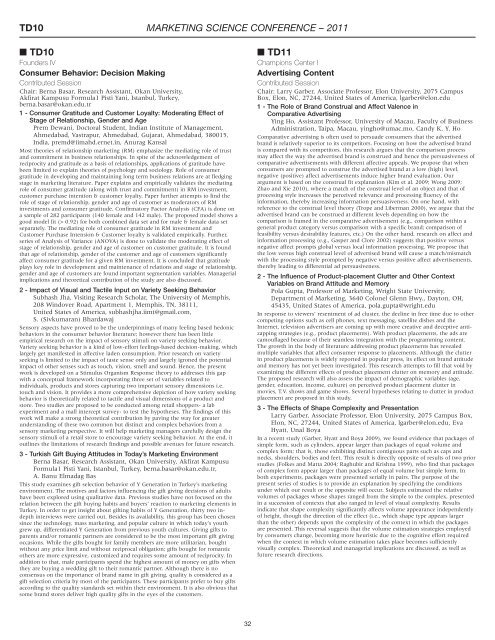Conference Sessions - Jesse H. Jones Graduate School of ...
Conference Sessions - Jesse H. Jones Graduate School of ...
Conference Sessions - Jesse H. Jones Graduate School of ...
Create successful ePaper yourself
Turn your PDF publications into a flip-book with our unique Google optimized e-Paper software.
TD10 MARKETING SCIENCE CONFERENCE – 2011<br />
■ TD10<br />
Founders IV<br />
Consumer Behavior: Decision Making<br />
Contributed Session<br />
Chair: Berna Basar, Research Assistant, Okan University,<br />
Akfirat Kampusu Formula1 Pisti Yani, Istanbul, Turkey,<br />
berna.basar@okan.edu.tr<br />
1 - Consumer Gratitude and Customer Loyalty: Moderating Effect <strong>of</strong><br />
Stage <strong>of</strong> Relationship, Gender and Age<br />
Prem Dewani, Doctoral Student, Indian Institute <strong>of</strong> Management,<br />
Ahmedabad, Vastrapur, Ahmedabad, Gujarat, Ahmedabad, 380015,<br />
India, premd@iimahd.ernet.in, Anurag Kansal<br />
Most theories <strong>of</strong> relationship marketing (RM) emphasize the mediating role <strong>of</strong> trust<br />
and commitment in business relationships. In spite <strong>of</strong> the acknowledgement <strong>of</strong><br />
reciprocity and gratitude as a basis <strong>of</strong> relationships, applications <strong>of</strong> gratitude have<br />
been limited to explain theories <strong>of</strong> psychology and sociology. Role <strong>of</strong> consumer<br />
gratitude in developing and maintaining long term business relations are at fledging<br />
stage in marketing literature. Paper explains and empirically validates the mediating<br />
role <strong>of</strong> consumer gratitude (along with trust and commitment) in RM investment,<br />
customer purchase intention & customer loyalty. Paper further attempts to find the<br />
role <strong>of</strong> stage <strong>of</strong> relationship, gender and age <strong>of</strong> customer as moderators <strong>of</strong> RM<br />
investments and consumer gratitude. Confirmatory Factor Analysis (CFA) is done on<br />
a sample <strong>of</strong> 282 participants (140 female and 142 male). The proposed model shows a<br />
good model fit (> 0.92) for both combined data set and for male & female data set<br />
separately. The mediating role <strong>of</strong> consumer gratitude in RM investment and<br />
Customer Purchase Intension & Customer loyalty is validated empirically. Further,<br />
series <strong>of</strong> Analysis <strong>of</strong> Variance (ANOVA) is done to validate the moderating effect <strong>of</strong><br />
stage <strong>of</strong> relationship, gender and age <strong>of</strong> customer on customer gratitude. It is found<br />
that age <strong>of</strong> relationship, gender <strong>of</strong> the customer and age <strong>of</strong> customers significantly<br />
affect consumer gratitude for a given RM investment. It is concluded that gratitude<br />
plays key role in development and maintenance <strong>of</strong> relations and stage <strong>of</strong> relationship,<br />
gender and age <strong>of</strong> customers are found important segmentation variables. Managerial<br />
implications and theoretical contribution <strong>of</strong> the study are also discussed.<br />
2 - Impact <strong>of</strong> Visual and Tactile Input on Variety Seeking Behavior<br />
Subhash Jha, Visiting Research Scholar, The University <strong>of</strong> Memphis,<br />
208 Windover Road, Apartment 1, Memphis, TN, 38111,<br />
United States <strong>of</strong> America, subhashjha.iimt@gmail.com,<br />
S. (Sivkumaran) Bhardawaj<br />
Sensory aspects have proved to be the underpinnings <strong>of</strong> many feeling based hedonic<br />
behaviors in the consumer behavior literature; however there has been little<br />
empirical research on the impact <strong>of</strong> sensory stimuli on variety seeking behavior.<br />
Variety seeking behavior is a kind <strong>of</strong> low-effort feelings-based decision-making, which<br />
largely get manifested in affective laden consumption. Prior research on variety<br />
seeking is limited to the impact <strong>of</strong> taste sense only and largely igroned the potential<br />
impact <strong>of</strong> other senses such as touch, vision, smell and sound. Hence, the present<br />
work is developed on a Stimulus Organism Response theory to addresses this gap<br />
with a conceptual framework incorporating three set <strong>of</strong> variables related to<br />
individuals, products and stores capturing two important sensory dimensions i.e.<br />
touch and vision. It provides a more comprehensive depiction <strong>of</strong> how variety seeking<br />
behavior is theoretically related to tactile and visual dimensions <strong>of</strong> a product and<br />
store. Two studies are proposed to be conducted among retail shoppers- a lab<br />
experiment and a mall intercept survey- to test the hypotheses. The findings <strong>of</strong> this<br />
work will make a strong theoretical contribution by paving the way for greater<br />
understanding <strong>of</strong> these two common but distinct and complex behaviors from a<br />
sensory marketing perspective. It will help marketing managers carefully design the<br />
sensory stimuli <strong>of</strong> a retail store to encourage variety seeking behavior. At the end, it<br />
outlines the limitations <strong>of</strong> research findings and possible avenues for future research.<br />
3 - Turkish Gift Buying Attitudes in Today’s Marketing Environment<br />
Berna Basar, Research Assistant, Okan University, Akfirat Kampusu<br />
Formula1 Pisti Yani, Istanbul, Turkey, berna.basar@okan.edu.tr,<br />
A. Banu Elmadag Bas<br />
This study examines gift selection behavior <strong>of</strong> Y Generation in Turkey’s marketing<br />
environment. The motives and factors influencing the gift giving decisions <strong>of</strong> adults<br />
have been explored using qualitative data. Previous studies have not focused on the<br />
relation between the gift buying habits and buyers’ reaction to marketing elements in<br />
Turkey. In order to get insight about gifting habits <strong>of</strong> Y Generation, thirty two indepth<br />
interviews were carried out. Besides its availability, this group has been chosen<br />
since the technology, mass marketing, and popular culture in which today’s youth<br />
grew up, differentiated Y Generation from previous youth cultures. Giving gifts to<br />
parents and/or romantic partners are considered to be the most important gift giving<br />
occasions. While the gifts bought for family members are more utilitarian, bought<br />
without any price limit and without reciprocal obligation; gifts bought for romantic<br />
others are more expressive, customized and requires some amount <strong>of</strong> reciprocity. In<br />
addition to that, male participants spend the highest amount <strong>of</strong> money on gifts when<br />
they are buying a wedding gift to their romantic partner. Although there is no<br />
consensus on the importance <strong>of</strong> brand name in gift giving, quality is considered as a<br />
gift selection criteria by most <strong>of</strong> the participants. These participants prefer to buy gifts<br />
according to the quality standards set within their environment. It is also obvious that<br />
some brand stores deliver high quality gifts in the eyes <strong>of</strong> the customers.<br />
32<br />
■ TD11<br />
Champions Center I<br />
Advertising Content<br />
Contributed Session<br />
Chair: Larry Garber, Associate Pr<strong>of</strong>essor, Elon University, 2075 Campus<br />
Box, Elon, NC, 27244, United States <strong>of</strong> America, lgarber@elon.edu<br />
1 - The Role <strong>of</strong> Brand Construal and Affect Valence in<br />
Comparative Advertising<br />
Ying Ho, Assistant Pr<strong>of</strong>essor, University <strong>of</strong> Macau, Faculty <strong>of</strong> Business<br />
Administration, Taipa, Macau, yingho@umac.mo, Candy K. Y. Ho<br />
Comparative advertising is <strong>of</strong>ten used to persuade consumers that the advertised<br />
brand is relatively superior to its competitors. Focusing on how the advertised brand<br />
is compared with its competitors, this research argues that the comparison process<br />
may affect the way the advertised brand is construed and hence the persuasiveness <strong>of</strong><br />
comparative advertisements with different affective appeals. We propose that when<br />
consumers are prompted to construe the advertised brand at a low (high) level,<br />
negative (positive) affect advertisements induce higher brand evaluation. Our<br />
argument is based on the construal fit explanation (Kim et al. 2009; Wong 2009;<br />
Zhao and Xie 2010), where a match <strong>of</strong> the construal level <strong>of</strong> an object and that <strong>of</strong><br />
processing style increases the perceived relevance and processing fluency <strong>of</strong> the<br />
information, thereby increasing information persuasiveness. On one hand, with<br />
reference to the construal level theory (Trope and Liberman 2000), we argue that the<br />
advertised brand can be construed at different levels depending on how the<br />
comparison is framed in the comparative advertisement (e.g., comparison within a<br />
general product category versus comparison with a specific brand; comparison <strong>of</strong><br />
feasibility versus desirability features, etc.) On the other hand, research on affect and<br />
information processing (e.g., Gasper and Clore 2002) suggests that positive versus<br />
negative affect prompts global versus local information processing. We propose that<br />
the low versus high construal level <strong>of</strong> advertised brand will cause a match/mismatch<br />
with the processing style prompted by negative versus positive affect advertisements,<br />
thereby leading to differential ad persuasiveness.<br />
2 - The Influence <strong>of</strong> Product-placement Clutter and Other Context<br />
Variables on Brand Attitude and Memory<br />
Pola Gupta, Pr<strong>of</strong>essor <strong>of</strong> Marketing, Wright State University,<br />
Department <strong>of</strong> Marketing, 3640 Colonel Glenn Hwy., Dayton, OH,<br />
45435, United States <strong>of</strong> America, pola.gupta@wright.edu<br />
In response to viewers’ resentment <strong>of</strong> ad cluster, the decline in free time due to other<br />
competing options such as cell phones, text messaging, satellite dishes and the<br />
Internet, television advertisers are coming up with more creative and deceptive antizapping<br />
strategies (e.g., product placements). With product placements, the ads are<br />
camouflaged because <strong>of</strong> their seamless integration with the programming content.<br />
The growth in the body <strong>of</strong> literature addressing product placements has revealed<br />
multiple variables that affect consumer response to placements. Although the clutter<br />
in product placements is widely reported in popular press, its effect on brand attitude<br />
and memory has not yet been investigated. This research attempts to fill that void by<br />
examining the different effects <strong>of</strong> product placement clutter on memory and attitude.<br />
The proposed research will also assess the impact <strong>of</strong> demographic variables (age,<br />
gender, education, income, culture) on perceived product placement clutter in<br />
movies, T.V. shows and game shows. Several hypotheses relating to clutter in product<br />
placement are proposed in this study.<br />
3 - The Effects <strong>of</strong> Shape Complexity and Presentation<br />
Larry Garber, Associate Pr<strong>of</strong>essor, Elon University, 2075 Campus Box,<br />
Elon, NC, 27244, United States <strong>of</strong> America, lgarber@elon.edu, Eva<br />
Hyatt, Unal Boya<br />
In a recent study (Garber, Hyatt and Boya 2009), we found evidence that packages <strong>of</strong><br />
simple form, such as cylinders, appear larger than packages <strong>of</strong> equal volume and<br />
complex form; that is, those exhibiting distinct contiguous parts such as caps and<br />
necks, shoulders, bodies and feet. This result is directly opposite <strong>of</strong> results <strong>of</strong> two prior<br />
studies (Folkes and Matta 2004; Raghubir and Krishna 1999), who find that packages<br />
<strong>of</strong> complex form appear larger than packages <strong>of</strong> equal volume but simple form. In<br />
both experiments, packages were presented serially in pairs. The purpose <strong>of</strong> the<br />
present series <strong>of</strong> studies is to provide an explanation by specifying the conditions<br />
under which our result or the opposite will occur. Subjects estimated the relative<br />
volumes <strong>of</strong> packages whose shapes ranged from the simple to the complex, presented<br />
in a succession <strong>of</strong> contexts that also ranged in level <strong>of</strong> visual complexity. Results<br />
indicate that shape complexity significantly affects volume appearance independently<br />
<strong>of</strong> height, though the direction <strong>of</strong> the effect (i.e., which shape type appears larger<br />
than the other) depends upon the complexity <strong>of</strong> the context in which the packages<br />
are presented. This reversal suggests that the volume estimation strategies employed<br />
by consumers change, becoming more heuristic due to the cognitive effort required<br />
when the context in which volume estimation takes place becomes sufficiently<br />
visually complex. Theoretical and managerial implications are discussed, as well as<br />
future research directions.

















